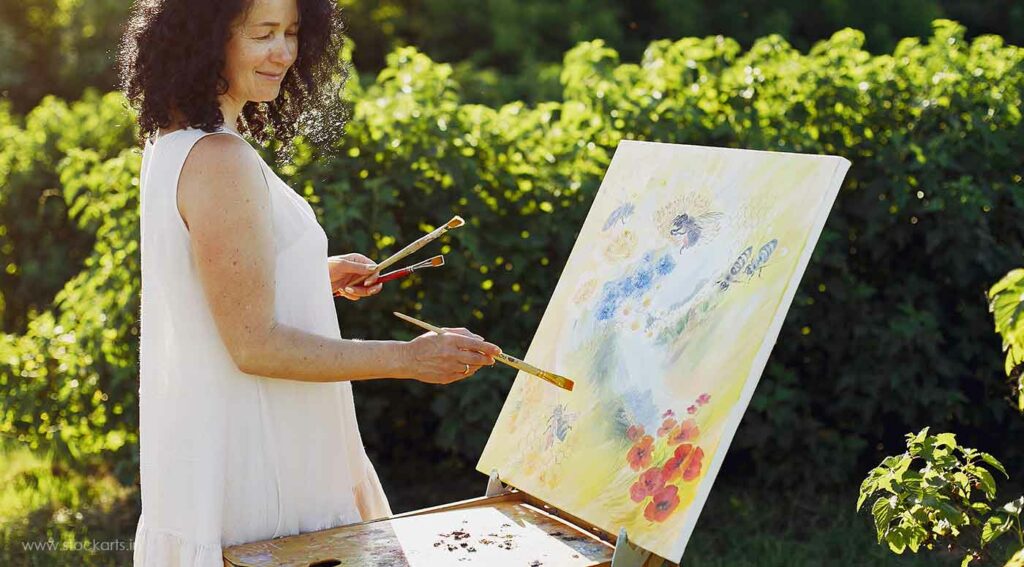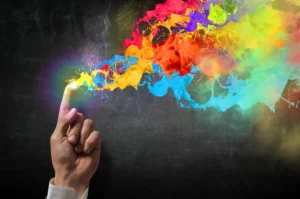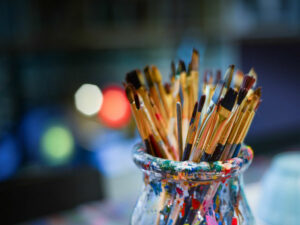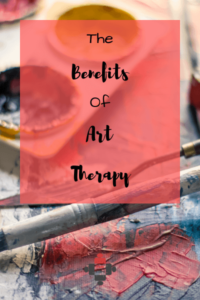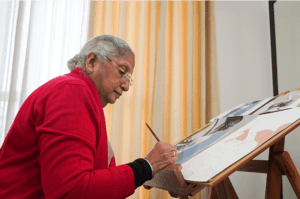Art therapy has been around for many, many years. In fact, it is one of the oldest therapy types for mental health treatment in the world. It is a process that helps people with trauma or stress. They can use art materials to express their feelings and get better. Even outside of this therapeutic context, art-making can be a powerful way to connect with oneself and others on a deep level. We will talk about how people can use creativity as a way of expressing themselves. This can happen both inside and outside of a professional setting.
Contents
- 1 What Is Art Therapy?
- 1.1 Types Of Art Therapy
- 1.2 Origin Of Art Therapy
- 1.3 How Does Art Therapy Work?
- 1.4 Benefits Of Art Therapy
- 1.5 Who Can Benefit From Art Therapy?
- 1.6 What To Expect In Art Therapy?
- 1.7 How Can You Start?
- 1.8 Techqnuies Of Art Therapy
- 1.9 How Can You Implement Art Therapy In Your Life?
- 1.10 Other Creative Therapies
- 2 Conclusion
What Is Art Therapy?
Art therapy is a form of psychotherapy that uses the creative process to improve mental health. Many art therapists use mixed media, such as paint and different kinds of paper, as well as found objects like buttons or shells. In this therapy, people use art to heal and cope with emotional or mental health issues. It can be helpful for people of all ages, and it is very helpful to treat a variety of conditions.
Types Of Art Therapy
There are different types of art therapy. Some common ones include art psychotherapy, expressive arts therapy, creative arts therapy, and group art therapy:
Art Psychotherapy
This is also known as applied or clinical art therapy. Art psychotherapists use the visual imagery created in a client’s artwork to understand their mental health issues better so they can develop treatment plans for them.
This form of analysis uses an aggregate number of drawings or paintings made by clients over time, rather than specific pieces that may have deeper meaning on their own.
Expressive Arts Therapy
Expressive arts therapists believe that using creativity is a good way to help people express themselves. It makes it easier for them to be heard even if they struggle with verbal communication or find other forms traumatic. This type of therapy is very useful for people who have experienced trauma.
Creative Arts Therapy
Creative arts therapists believe that the creative process can help people change their lives in positive ways. They work with their clients to use different kinds of art, such as music, dance, drama, and visual arts, to achieve this goal.
Group Art Therapy
Group art therapy is a form of psychotherapy that uses the creative process to improve mental health. Many art therapists use mixed media, such as paint and different kinds of paper, as well as found objects like buttons or shells. In this therapy, people use art to heal and cope with emotional or mental health issues. It can be helpful for people of all ages, and it is very helpful to treat a variety of conditions.
Origin Of Art Therapy
The origin of art therapy is unknown, but it is thought to have started in the early 1900s. The first time the term “art therapy” was used was in 1917 by Dr. Margaret Naumberg. She was a psychiatric social worker who worked with soldiers during World War I. She used art as a way for them to express their feelings about the war and their experiences.
Since then, art therapy has been used to help people deal with all kinds of issues, including mental health problems, addiction, abuse, and trauma. It can be helpful for people of all ages, genders, and cultures.
How Does Art Therapy Work?
No one really knows how art therapy works exactly, but there are some theories about it:
- Some people believe that the creative process helps people access parts of their brains that they can’t reach with words.
- This can help them understand and cope with their emotions and mental health issues.
- Others believe that the act of creating art itself is therapeutic. It can help people relax and focus.
- It also helps people express themselves in ways they might not otherwise be able to.
- Finally, some believe that working on a project together in a group setting can be helpful for building relationships and social skills.
Benefits Of Art Therapy
There are many benefits of art therapy, such as helping
- People understand and cope with their emotions and mental health issues
- In relax and focus on their life
- People express themselves in ways they might not otherwise be able to
- Building relationships and social skills
- Reducing stress
- Improving creativity
- Improving problem-solving skills
- Helping people access parts of their brains that they can’t reach with words
Who Can Benefit From Art Therapy?
Art therapy can benefit anyone who is creative and wants to use that creativity to improve their mental health. It can be helpful for people of all ages, genders, and cultures. Some conditions that art therapy can help with include:
- Health Problems – Art therapy can be used to help people deal with physical and mental health problems.
- Mental Health Issues – Art therapy helps people who have mental health conditions. It can help with depression, bullying, addiction, abuse, eating disorders like anorexia nervosa or bulimia nervosa, mood swings caused by bipolar disorder or schizophrenia, and anxiety. It is often helpful for children who have been abused.
- Stress And Anxiety – Art therapy has also been shown to reduce stress levels in students as well as adults from all walks of life. Children with Autism Spectrum Disorder (ASD) also have a lot of problems with learning and thinking. Kids with these issues often have mental retardation, dyslexia, ADHD, or other disabilities. That is why it’s hard for them to express themselves in creative ways. This can happen when children are born too early or after something bad has happened to them like sexual abuse or domestic violence.
- Groups – Group art therapy can be helpful for building relationships and social skills. It is often used with people who have mental health issues, such as addiction or trauma.
What To Expect In Art Therapy?
In art therapy, you will be asked to do a variety of different things. you might be asked to do artwork, write about your feelings or work on projects with other people. You can also talk about what you are feeling.
You should always talk to your therapist about what you are comfortable doing. If you don’t want to do something, then your therapist should not make you do it. It is okay if they ask and then gives up after a while. However, it is important to remember that the goal of art therapy is to help you feel better mentally and emotionally, so your therapist will probably encourage you to do anything that might help.
How Can You Start?
There are many different ways to start doing art therapy:
- It can be done alone, with one person who acts as a therapist, or in groups of varying sizes.
- One way is by using mixed media materials like paint, paper, markers, crayons, clay pieces, stringed beads to create abstract pieces that have no meaning other than what the artist wants them to mean for themselves.
- This process will help you explore your emotions without having any expectations about how it should turn out or what it is at all. Another option is to use collage materials like yarn, fabric scraps, wire pieces to create objects that portray how you are feeling.
- This process will help you express feelings in a more tangible way than if you were only using words or abstract art!
- You can also make artwork by cutting up old magazines and newspapers into interesting shapes before gluing them onto paper. This type of project shows your creativity while helping you focus on what’s important to know about yourself.
- Some people may feel hesitant to try art therapy because they think that they are not “artistic” enough. However, art therapy is not about being artistic – it is about using creativity as a way to express yourself. Anyone can do it! In fact, many people who participate in art therapy sessions find that they become more creative over time. This is because the process of creating artwork helps them explore their feelings and thoughts in a new way.
Techqnuies Of Art Therapy
There are many different techniques in art therapy, but there are three main categories:
Creative expression
Creative expression is the simplest thing that you will do when participating in an art therapy session. This type of activity does not need any special preparation. All you have to do is create with whatever materials are available at the time. This process helps people communicate their feelings through visual means without being limited by words or language itself.
Art-making
Art-making activities include cutting out shapes from magazines and newspapers before gluing them onto paper, collage projects using mixed media materials like paint, clay pieces, markers, crayons, etc., stringed bead creations where beads are threaded together on an of wire or yarn to form abstract designs, and much more. This type of project is great for exploring emotions because it allows you to be creative while also having a tangible end product that can be displayed or shared with others.
Reflection
Reflection therapy happens when you take what you have created in an art-making activity and write about it, talk about it with your therapist, or otherwise reflect on its meaning. This step helps people connect the artwork they create with their feelings and thoughts, providing insight into their mental state at that particular time.
When reflecting on the artwork, some questions that can be asked are: “What does this image represent to me?”, “How do I feel when looking at this piece?”, “What was going through my mind when I made this?” etc. Reflecting on your artwork in this way helps you to make connections between what it means for you, how it makes you feel, and even why a particular piece might have been created. This is a valuable step that often brings up new insights about oneself!
How Can You Implement Art Therapy In Your Life?
One can implement Art Therapy In their Life in many ways such as:
- One of the best things about art therapy is that anyone can do it at any time without having to organize anything beforehand or prepare materials.
- Anyone who wants to try something easy yet rewarding should definitely give art therapy a go, there are no limitations on who can participate. All you need is some creativity along with a willingness to explore yourself through artistic expression.
Here are some ideas:
- When feeling stressed out, grab some crayons, markers, or colored pencils and draw about what’s bothering you.
- Look through magazines for some interesting shapes to cut out before gluing them onto paper to make a collage.
- Cut strips of construction paper in various widths and colors, then use yarn or string to weave the pieces together into abstract designs that are all your own.
Other Creative Therapies
Art therapy is just one type of creative therapy that you can try. There are many others, all with their unique benefits and applications:
Writing
Writing about feelings in a journal is one way to use creativity as an outlet for emotions. You may also choose to write poems or short stories where your main character goes through similar challenges that you have faced in the past. This allows you to explore your thoughts and feelings using written language instead of images or shapes on paper.
Dance
Movement is another natural way for people to express themselves creatively without words getting in the way. Dance activities like Zumba allow participants to let loose while doing something fun at the same time! It’s not only good exercise but it helps people connect with their emotions through the motions and rhythms of dance.
Sculpting
Clay, Play-Doh, and other modeling materials are used to create sculptures that represent aspects of your life or inner world. This is a great way to visualize difficult concepts or feelings in a tangible way that can be looked at and analyzed from all angles.
Music
Making music can help people process thoughts and emotions in a very deep way. Many people say that music is the language of the soul, so it makes perfect sense that this type of creative therapy would be so effective. Singing along to your favorite songs or playing an instrument are both great ways to start with this type of activity.
Creative therapies offer people a way to express themselves in a way that is not bound by traditional rules or structure. This can be liberating for those who feel like they don’t fit into the “normal” way of doing things. Trying out a few different creative therapies is a great way to see which one works best for you and helps you to feel your best.
Art therapy isn’t just about making art- it’s also about exploring yourself through artistic expression. When you take the time to reflect on your artwork, you may find new insights into your thoughts and feelings that you never realized before. Creative therapies like these are a great way to connect with yourself in a deep and meaningful way.
Conclusion
Art therapy is very helpful to help patients with a variety of mental health issues. For example, art therapy is been very beneficial for people who are coping with addiction, post-traumatic stress disorder (PTSD), depression, and anxiety. It also provides relief for those suffering from schizophrenia or dementia by helping them reconnect emotionally with their environment. If you’ve never tried art therapy before but think this might be something you want to explore, we would love to hear more about your goals and wants in order to provide you with the best possible care plan for your unique needs.
If you are looking for affordable Online Counseling MantraCare can help: Book a trial therapy session
